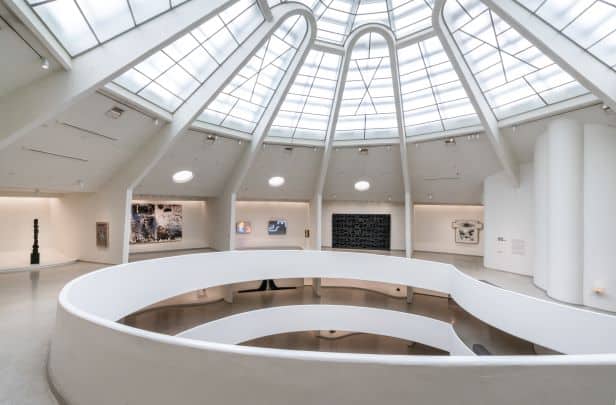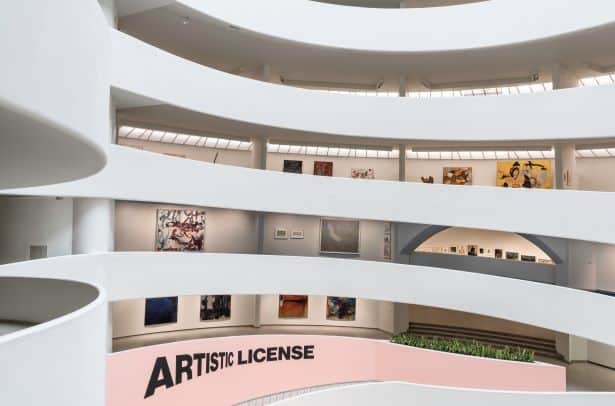Artistic License: Six Takes on the Guggenheim Collection
When the American architect Frank Lloyd Wright subverted typical art gallery layouts with a spiral ramp, he opened up a new perspective for enthusiasts of avaunt garde art everywhere. "I think the legacy of this building is in the message that architecture does not have to lie down and play dead in front of art," said Paul Goldberger, an architecture critic for The New Yorker. "That there are other ways to show art than in a neutral space. That an architect can do something, that's powerful in itself, and that enhances the experience..."

© Solomon R. Guggenheim Foundation
Sixty years on, the Guggenheim is celebrating Frank Lloyd Wright’s contribution to the enjoyment of art with its first-ever artist-curated exhibition. Presented by Cai Guo-Qiang, Paul Chan, Jenny Holzer, Julie Mehretu, Richard Prince, and Carrie Mae Weems, the collection highlights works of art from the turn of the century to 1980.
What is Artistic License?
Artistic License presents nearly 300 paintings, sculptures, works on paper, and installations. Some of these works have never been exhibited before and engage with contemporary hot topics. Think early modernist dreams of utopia and the charged political debates of the 1960s and ’70s as just some of these themes.

© Solomon R. Guggenheim Foundation
The artist collective curating the exhibition have drawn upon their own practises and influences when selecting the artworks. In this way, every one of the six ramps in the rotunda is a starkly new reading of the collection.
Curator profiles and what to expect
Cai Guo-Qiang
Influences and work: Eastern philosophy and contemporary social issues.
Featured artists: Featured artworks include Vasily Kandinsky’s Munich(ca. 1901–02), Piet Mondrian’s Blue Chrysanthemum (ca. early 1920s), Mark Rothko’s still life Untitled (Still-Life with Rope, Hammer and Trowel) (ca. 1937), and works on paper by artist Hilla Rebay, who was also the Guggenheim’s first director. Installed salon style.
Location: High Gallery and Rotunda Level 1
Themes: Primordial passions that ignite the creation of art on paper by artists known for their abstract or conceptual practices.

© 2019 Successió Miró / Artists Rights Society (ARS), New York / ADAGP, Paris
Paul Chan
Influences and work: Experimental projects. Chan is known for a diverse practice that ranges from animated video projections to charcoal drawing, public performances, and haunting sculptures.
Featured artists: Chan’s selections range from Fernand Léger’s late painting Starfish (1942) to Lawrence Weiner’s conceptual work (1970), and from Willem de Kooning’s canvas ...Whose Name Was Writ in Water (1975) to Laurie Simmons’s photographs of dollhouse-scale bathroom scenes from the 1970s.
Location: Rotunda Level 2
Themes: Bathers in Western art history and ideas about water, relationships between pleasure and the human body. Exile in the canon of twentieth-century art will also be explored.

© Laurie Simmons
Jenny Holzer
Influences and work: The deconstruction of how meaning is created in Western culture’s patriarchal, consumer-oriented society.
Featured artists: Lee Bontecou’s sculptural relief Untitled (1966), Louise Nevelson’s monumental wall sculpture Luminous Zag: Night (1971), Adrian Piper’s self-portrait The Mythic Being: Smoke (1974), a selection of Chryssa’s neon works and a canvas from the 1960s and ’70s.
Location: Rotunda Level 6
Themes: This presentation illuminates gender disparity and the exclusion of women from art history. Holzer has selected works made exclusively by female artists.

© Adrian Piper
Julie Mehretu
Influences and work: Large-scale paintings and works on paper. Mehretu’s work is inspired by global urban landscapes, political unrest, and modernist history.
Featured artists: Featured works include Francis Bacon’s Three Studies for a Crucifixion (March 1962), Romare Bearden’s gelatin silver print (photostat) Evening 9:10, 461 Lenox Avenue (1964), Matta’s painting Years of Fear (1941), and David Hammons’s body print Close Your Eyes and See Black (1969)—a recent acquisition.
Location: Rotunda Level 4
Themes: This presentation reflects on how trauma, displacement, and anxiety in the decades after World War II found expression.

© 2019 The Estate of Francis Bacon. All rights reserved / Artists Rights Society (ARS), New York/DACS, London
Richard Prince
Influences and work: Prince pioneered the use of appropriation in his early photo-based works and “Monochromatic Joke” paintings to comment upon the way desire is created and perpetuated in the mass media.
Featured artists: Featured works include those by Martin Barré, Conrad Marca-Relli, Georges Mathieu, Kenzo Okada, and Judit Reigl, among others. Prince has also included two canvases by Stuart Sutcliffe (an early member of the Beatles).
Location: Rotunda Level 3
Themes: The stark similarities in the formal qualities of the museum’s international holdings of abstract painting and sculpture from the 1940s and ’50s. He raises the question of how, ultimately, taste is formed.

© 2019 Artists Rights Society (ARS), New York / ADAGP, Paris
Carrie Mae Weems
Influences and work: Interrogations of systems as they relate to the constructions of power, race, gender, and class.
Featured artists: Featured works include Joseph Beuys’s installation Virgin(April 4, 1979); Franz Kline’s Painting No. 7 (1952); Mark Rothko’s Untitled (Black on Gray) (1969/70); examples from Ana Mendieta’s Silueta Series, which she began in 1973; and Martin Puryear’s sculpture Bask (1976).
Location: Rotunda Level 5
Themes: The formal and metaphoric use of a strictly black-and-white palette across different decades, mediums, and genres.

© 2019 Artists Rights Society (ARS), New York/VG Bild-Kunst, Bonn
June 18: Cai Guo-Qiang
July 30: Jenny Holzer
September 24: Julie Mehretu
October 8: Paul Chan
November 19: Carrie Mae Weems
December 17: Richard Prince
Enjoy free entry into the Guggenheim Museum with The New York Pass.
Need another art fix? Check out our MoMA blog.